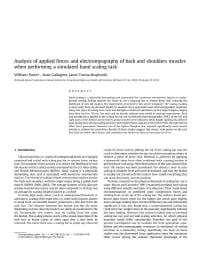Mining Publication: Analysis of Applied Forces and Electromyography of Back and Shoulders Muscles When Performing A Simulated Hand Scaling Task
Original creation date: May 2010
Authors: WL Porter, S Gallagher, J Torma-Krajewski
Hand scaling is a physically demanding task responsible for numerous overexertion injuries in underground mining. Scaling requires the miner to use a long pry bar to remove loose rock, reducing the likelihood of rock fall injuries. The experiments described in this article simulated rib scaling (scaling a mine wall) from an elevated bucket to examine force generation and electromyographic responses using two types of scaling bars (steel and fiberglass-reinforced aluminum) at five target heights ranging from floor level to 176 cm. Ten male and six female subjects were tested in separate experiments. Peak and average force applied at the scaling bar tip and normalized electromyography (EMG) of the left and right pairs of the deltoid and erectores spinae muscles were obtained. Work height significantly affected peak prying force during scaling activities with highest force capacity at the lower levels. Bar type did not affect force generation. However, use of the lighter fiberglass bar required significantly more muscle activity to achieve the same force. Results of these studies suggest that miners scale points on the rock face that are below their knees, and reposition the bucket as often as necessary to do so.

- A Comparison of Fatigue Failure Responses of Old Versus Middle-Aged Lumbar Motion Segments in Simulated Flexed Lifting
- Effects of Lifting in Four Restricted Postures
- The Effects of Scaling Height and Scaling Bar Design on Applied Forces and Bilateral Muscle Activity of the Back and Shoulders
- An Exploratory Study of Loading and Morphometric Factors Associated with Specific Failure Modes in Fatigue Testing of Lumbar Motion Segments
- Locomotion in Restricted space: Kinematic and Electromyographic Analysis of Stoopwalking and Crawling
- Nature and Cost of Low Back Pain
- Reducing Low Back Pain and Disability in Mining
- Technology News 483 - Safety Training Tools for Rock Scaling Personnel
- Trunk Extension Strength and Muscle Activity in Standing and Kneeling Postures
- Upper Extremity Joint Moment and Force Predictions When Using a Joystick Control